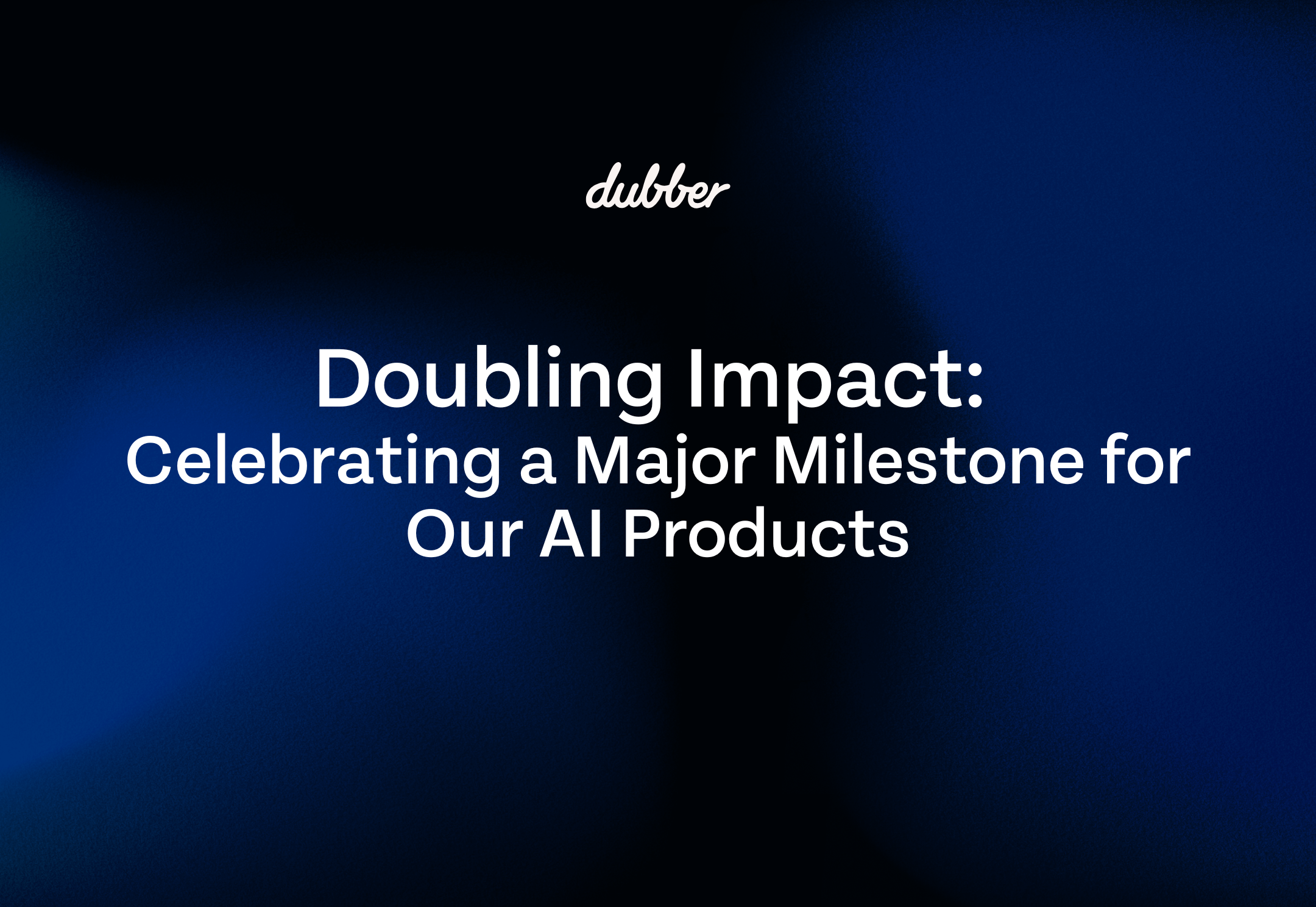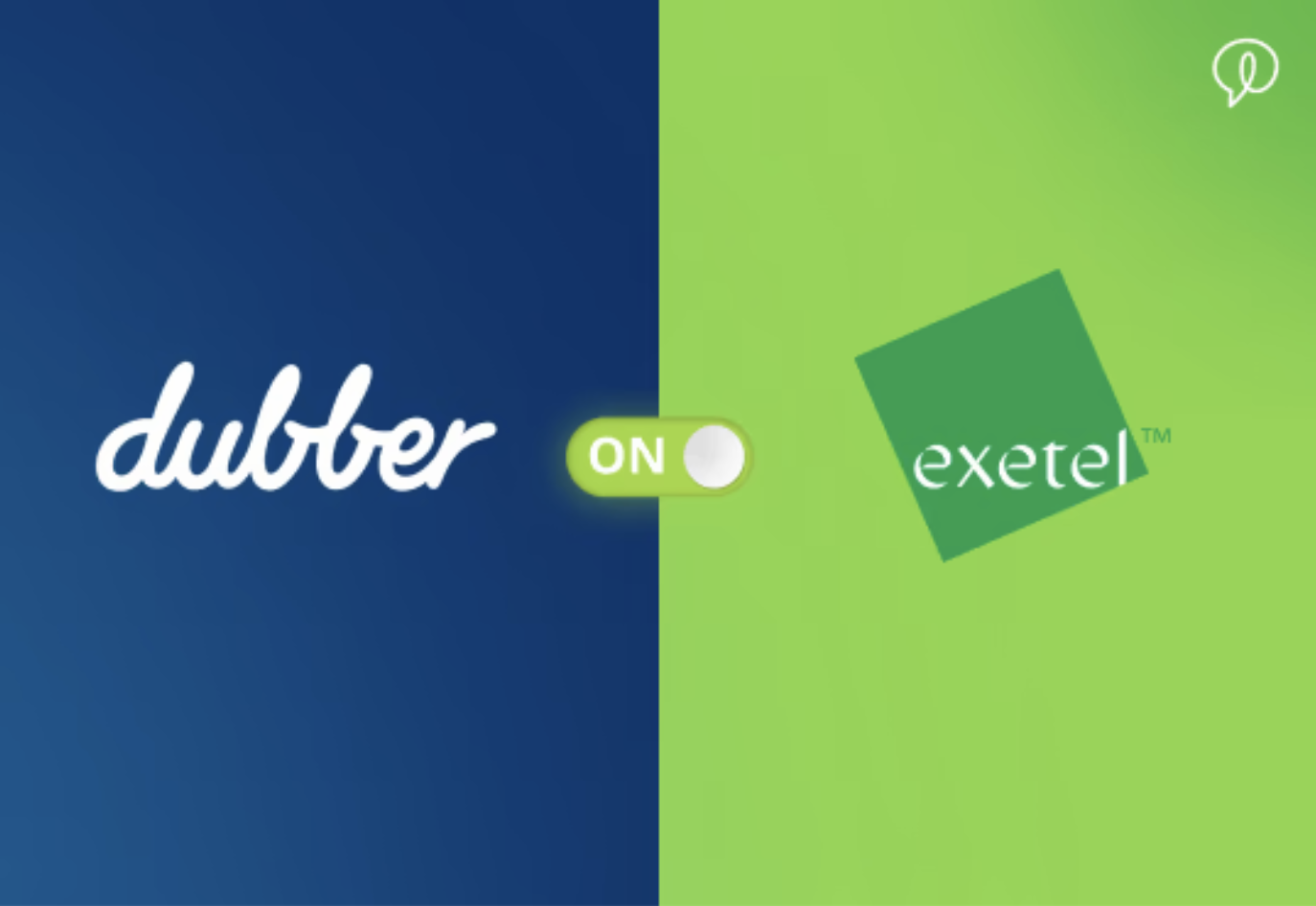
Exetel today announced a game-changing partnership with Dubber, a global leader in Unified Call Recording and Voice Intelligence solutions.
Integrating Dubber’s voice data and artificial intelligence into Banter, its own scalable cloud PBX, unified communications and collaboration platform for business customers, Exetel announced the Australian-first functionality was available as a standard and in-built feature of its VOIP services for business customers. Dubber’s Unified Call Recording will automatically record and transform every conversation on Banter into rich voice data for compliance, customer experience, call sentiment, evidence and performance improvement. Dubber will allow Exetel clients to eliminate the cost, complexity and risk of legacy call recording and unlock the benefits of voice data at scale.
Richard Purdy, Exetel Chief Executive Officer, said he was excited about the potential for business customers. “Bringing the power and intelligence of Dubber’s industry-leading solutions together with Banter’s intuitive and collaborative enterprise platform will drive a step-change in customer service levels not available on any other network in the country.
Steve McGovern, CEO, Dubber, said:
“We are delighted to be working with Exetel to bring the power of Dubber’s unified call recording services to customers on their Banter product suite. Exetel and Dubber share a common view about the importance of cloud-based communications driving the next wave of telecommunications innovation both in Australia and globally. We look forward to working closely with the Exetel team to bring scalable call recording and voice data to their business customers and helping clients to ‘end not knowing,” he said.
Responding last year to a suspected in-office case of COVID-19, the Exetel team deployed its own Banter service, a VOIP service that enabled its team to stand up a remote office and continue to work as if from their desk across fixed, desktop and mobile applications on the same day.
Purdy noted Banter was developed to provide all the functionality its business customers needed into a fully hosted business-grade collaboration platform. “It is fast to install, easy to use, fully flexible and will evolve and grow with a customer’s business. It has been a particularly attractive tool for our customers grappling with the evolving needs of working from home during the COVID period. Integrating Dubber’s Unified Call Recording and Voice Intelligence Solution into Banter takes the offering to another level altogether.”
“Voice sentiment identification is at the cutting edge of complaint resolution and Exetel is proud to partner with Dubber in bringing this service to market. Recording and storing conversations for proactive compliance and dispute resolution, continues to drive the need for voice data and intelligence at scale and Dubber is fast becoming known for its proven leadership in this space,” said Purdy.
For further information, please contact:Geoff Fowlstone
M: 0413746949
For additional information on Dubber on Banter, please visit:
About Dubber:
Dubber is unlocking the potential of voice data from any call or conversation. Dubber is the world’s most scalable Unified Call Recording service and Voice Intelligence Cloud adopted as core network infrastructure by multiple global leading telecommunications carriers in North America, Europe and Asia Pacific. Dubber allows service providers to offer call recording for compliance, business intelligence, sentiment analysis, AI and more on any phone. Dubber is a disruptive innovator in the multi-billion dollar call recording industry, its Software as a Service offering removes the need for on-premise hardware, applications or costly and limited storage.

Practical strategies and steps from the MS – Dubber webinar
Is the hybrid workplace here to stay? How do you meet post-pandemic demands for regaining compliance? And what role does technology play in enabling hybrid work flexibility, improving productivity and lifting CX and EX, all while minimizing risk?
In a recent webinar, Leon Wright, Microsoft’s Advanced Workloads Lead in Australia, together with Andy Lark, Chief Marketing Officer, Dubber, outlined the new hybrid work challenges, from siloed teams – to difficulties in accessing data for compliance insights.
Drawing from the webinar, we highlighted essential strategies to regain compliance in a hybrid workplace. We summarised for you ways organisations can now leverage voice technology to lift compliance and derive critical insights from customer conversations in the hybrid workplace.
The good, the bad and the promise of the hybrid paradox
Microsoft’s Leon Wright believes Covid is just the beginning of the disruption:
“Over a year into the pandemic, digital adoption curves are accelerating and the evidence is in the data: 80% of managers expect more flexible work from home policies post-pandemic. 73% of employees want flexible remote work options to stay and 67% of employees want more remote in-person and collaboration work.”
So how do you embrace flexible workplaces and processes and thrive?
You could start by creating a new work model that prioritizes social, knowledge and human capital. And you could embrace the Employee Experience (EX) and create more listening systems.
“If Covid has taught one thing, it is that managers were not listening… We need to get those listening systems working really well. It’s about configuring those systems for your best productivity,” Leon Wright, Microsoft.
Meeting recordings is fast becoming the new content channel
Leon Wright believes meeting recordings is going to be one of the fastest growing content types at Microsoft. “Recording has become the new champion of knowledge management. It’s a vital tool for continuous learning about customers and employees in a hybrid workplace. It’s not only the employee expectations that fundamentally changed; customer’s expectations have changed too, and we need to listen more to what they have to say.”
Organisations that embrace the seismic hybrid shift and explore ways to tune into their employees and customers may have more of a chance to succeed in this complex reality.
Are you listening? Overcoming distance in a connected world
As the workforce becomes more distant, it is more challenging to get our message across and understand correctly what’s been said between teams and customers.
There is a growing dependence on BYODs and rising use of BYOAs – Bring Your Own Applications. As a result, there is a growing difficulty to manage the Customer Experience (CX) and Employee Experience (EX) across multiple end-points, like mobile, messaging applications, VOIP applications, video meetings, and more. Employees are often switching between these multiple communications methods, and customers are demanding to be met where and how they communicate.
Voice is the largest untapped source of data and insights
Fortunately, cloud-based voice technologies evolved as one of the tools for managing this new complex hybrid workplace. Voice AI, in particular, is playing a vital role in improving CX, EX, compliance, and more. The ability to use AI to automate the otherwise impossible task of understanding sentiment and behavior during calls has become crucial.
“There has never been a more important time to establish a system of record… Many of us have forgotten just how many conversations are voice-based. Today more than 80% of crucial conversations are still voice and the value of that conversation ends as soon as it is over, ” Andy Lark, Dubber “If companies are not allowing compliance breaches to occur in email, they shouldn’t be happening in voice conversations.
The power of Unified Call Recording (UCR) and customer intelligence
The advantage of Dubber on video and call meeting platforms, such as MS Teams, Cisco’s Webex and Zoom, is you have all your conference calls, mobile conversations, SIP trunk connections, messaging, chat and more stored and retrieved from one secure and compliant place.
In the past, a single query, and there are hundreds of them a day, could take hours. Now you can drill down in seconds into conversation sets, pick up troubling keywords and easily review insightful transcriptions.
This impacts dispute resolution, contact centre calls tracking, employee training, sales revenue intelligence, and more.
In sum:
In this hybrid world, the upside of voice technology is the rise of new business performance, sales and productivity opportunities.
The ability to capture crucial conversations across remote and in-office environments and derive insights is paving the way to; improved employee engagement, boosted productivity, better outcomes in sales and compliance.
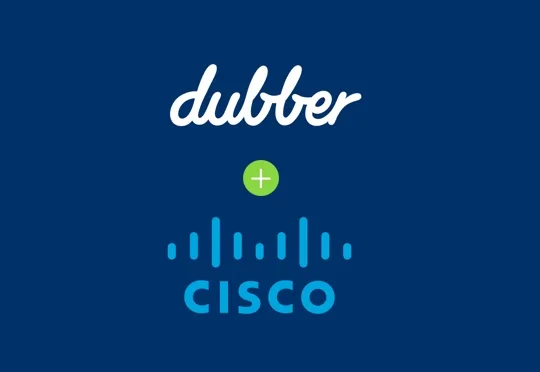
An instantly provisioned upgrade that gives you immediate differentiation? The ability to answer Cisco Webex and UCM Cloud compliance and security needs? A path to more revenue through easy and wanted upgrades?
Cisco and Dubber have you covered with today’s announcement that Dubber is powering call recording on Cisco Webex Calling and UCM Cloud. Your customers can compliantly record, store, share and replay any conversation. This critical new functionality turns on with a click at zero cost and is included in your Cisco subscription.
It’s on with a click
So here’s all you need to do. Whether a new or existing customer, simply turn on call recording in Cisco Control Hub. Your customer will need to accept the Dubber terms and conditions when doing so. That’s it.
From there, our customer success team will be available to assist with onboarding, training and more as you need it.
We’ve partnered with Cisco to reach out to all customers to ensure they are aware of how to compliantly record on Cisco and how to turn it on.
What’s included
Dubber is the global leader in unified call recording and voice AI solutions for compliance, revenue, customer and people intelligence. Basic call recording within Cisco will get you started on the path to ending not knowing, offering:
- Unlimited recordings of calls
- Cloud capture and storage
- Basic Enterprise controls and policy enforcement
- Easy access, replay, download and share from the Dubber app and web
- 30-day storage
Simple & easy path to more
If your customers require additional features such as extended team management, storage, transcription, video recording, sentiment analysis or AI-enriched insights (and much more), it’s simple to upgrade to Dubber solutions from within Cisco’s Control Hub with immediate access and effect.
Cisco partners will immediately benefit from any annual recurring revenue.
And there is more. Register to become a Dubber on Cisco partner today and get access to competitions, market development funds and much more.
Discover the benefits of unified call recording
Users that have compliance or regulatory requirements can easily ensure recording, replay and data storage on Cisco will meet their compliance obligations, regardless of the employee work location. A major concern and need for businesses as a result of the significant shift to remote and hybrid workforce arrangements.
“Expanding our relationship with Cisco marks a major milestone in increasing the ubiquity of Dubber as the Unified Call Recording and voice data layer for the world’s leading collaboration platforms,” said Steve McGovern, CEO, Dubber. “Our strong relationship with Cisco has been a critical part of our growth as a company and we share a common vision of the way that voice data will become a critical resource for all businesses and users in the future.”
A better way to hit replay
Unlike other embedded recording solutions, Dubber addresses critical data, privacy and regulatory requirements while providing a simple and easy pathway to richer functionality as it is required. Dubber recordings and AI-enriched data can easily be unified in the Dubber Voice Intelligence Cloud alongside conversations from other end-points such as landlines and mobile.
While other solutions offer the ability to record – something we call personal call recording – it’s the kind of recording ideal for an individual but not suitable for business or government. Here are a few of the reasons why:
- Secure cloud storage that can be managed centrally – avoiding privacy, data sovereignty and information leakage risks associated with recording to hardware
- Easily manage who can record and what can be recorded – implementing data and communications policies is made easy
- Controlled provisioning – via the Cisco Control Hub to ensure recordings are only available to eligible employees
Dubber also offers a range of Compliance-specific editions designed to meet the needs of highly regulated organisations and compliance teams.
“Business and Government require more than personal call recording,” said James Slaney, chief operating officer, Dubber. “They need conversations to be captured in a way that is compliant and converted to data for revenue intelligence, dispute resolution, proactive compliance and customer service. Today’s announcement is proof not only of the scalability of Dubber, but the potential we and Cisco see in tapping voice data to improve the performance of businesses and governments worldwide.”
How to start doing more with every conversation
Chat to Dubber on Cisco specialists ready to get your team or organization set up today – or your Cisco rep or partner. Dubber’s customer support team will be standing by to assist with any onboarding or training you or your team needs.
And if you need more than basic call recording for some or all of your users, our teams will assist in upgrading you to the world’s leading unified call recording solutions.
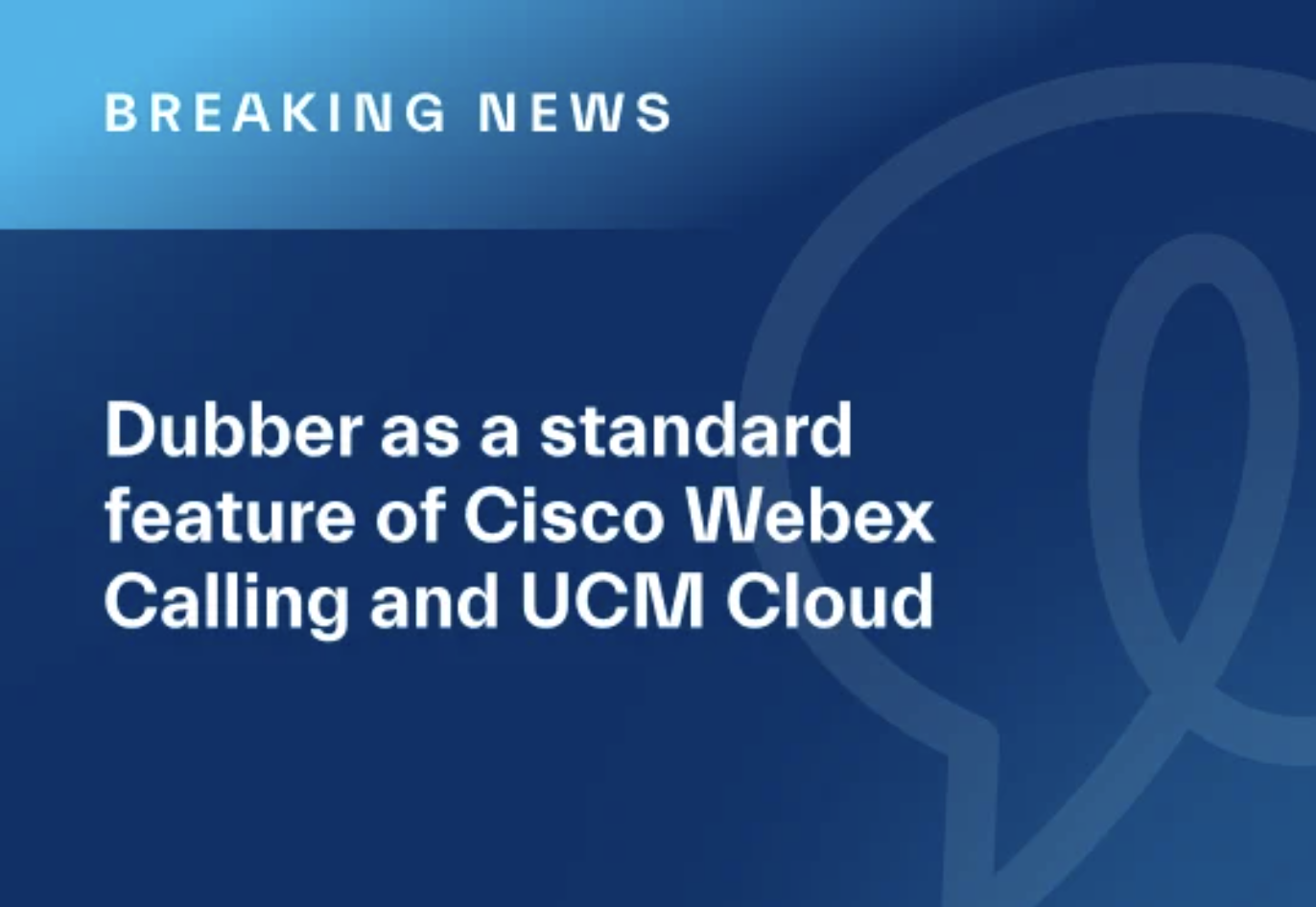
- Dubber now a standard feature on Cisco Webex Calling and UCM Cloud
- Dubber compliant Call Recording included in all subscriptions
- Cisco first Dubber Foundation Partner
Melbourne, Australia and Dallas, Texas – 3 June 2021 — Dubber Corporation Limited (ASX: DUB) (Dubber), today announced that Cisco Webex Calling and Cisco Unified Communications Manager Cloud (UCM) will now include Dubber call recording as part of all Cisco Webex and UCM services at no additional cost to users. See related blog post here.
Now, Webex Calling and UCM users with the ability to record any and all conversations as an included feature of their Webex subscription. If a user or business requires additional features such as extended storage, video recording, transcription, sentiment analysis or AI-enriched insights, they can simply upgrade their Dubber plan from within Cisco’s Control Hub with immediate access and effect.
Business users that have compliance or regulatory requirements to record and store calls can easily ensure recording, replay and data storage via the Cisco Webex platform, meeting their compliance obligations, regardless of the employee work location – a major concern for businesses as a result of the significant shift to remote and hybrid workforce arrangements.
“Cisco and Dubber share a common vision of the way that voice data will become a critical resource for all businesses and users in the future. This marks a major milestone in increasing the ubiquity of Dubber as the Unified Call Recording and voice data layer for the world’s leading collaboration platforms,” said Steve McGovern, CEO, Dubber
Cisco as a Foundation Partner
Additionally, Cisco will become Dubber’s first major Foundation Partner. The Dubber Foundation Partner Program utilises the scale and native cloud capability of the Dubber platform, enabling a service provider to embed Dubber within their core service and make basic call recording available for every user as a standard feature. Dubber and its Foundation Partners are then able to cross and upsell richer functionality for compliance, AI services, additional storage, insights and more.
McGovern added: “Dubber Foundation benefits Cisco and Dubber customers with a required capability as a standard feature while providing for the broader journey whereby the content of calls can be transformed into rich, usable data for compliance, productivity, insights and customer engagement.
“Customers worldwide are responding to increased regulatory and compliance obligations for their businesses. Embedding tools, like Dubber call recording, as a standard service that is available to Webex users will help customers meet those requirements while enabling easy access to powerful advanced voice data services,” said Lorrissa Horton, Vice President and General Manager of Webex Calling and Online.
“The Foundation Partner Program provides Dubber with a significant additional revenue stream while preserving our current revenue models and creating the opportunity to accelerate growth in our core products. Having 100% of a customer base enabled provides Dubber and Cisco the opportunity to significantly drive consumption and uptake of call recording and voice data services on the platform,” said McGovern.
As well as being an embedded solution, Dubber addresses critical data, privacy and regulatory requirements while providing a simple and easy pathway to richer functionality as it is required. Dubber recordings and AI-enriched data can easily be unified in the Dubber Voice Intelligence Cloud alongside conversations from other end-points such as land-lines and mobile.
“Business and Government require more than personal call recording,” said James Slaney, COO, Dubber. “They need conversations to be captured in a way that is compliant and converted to data for revenue intelligence, dispute resolution, proactive compliance and customer service. Today’s announcement is proof not only of the scalability of Dubber, but the potential we and Cisco see in tapping voice data to improve the performance of businesses and governments worldwide.”
Background: Dubber on Cisco Webex Calling and UCM Cloud:
- Available to all Cisco Webex Calling and UCM Cloud users as of today
- Dubber call recording on Cisco is free for any end user on the Webex Calling or UCM platforms
- Provides unlimited recordings stored for up to 30 days and is easily upgraded to unlimited storage for longer periods of time.
- Additional Dubber compliance, storage, transcription and AI plans are available immediately
- Access Cisco blog post here.
- Access Dubber on Webex via Cisco Control Hub
Background: Cisco UCM Cloud & Cisco Webex Calling recording:
Cisco® UCM Cloud provides enterprise-class call control, session management, voice, video, messaging, mobility, and conferencing services that are scalable, customizable, reliable, private and highly secure. In a sector where call recording is usually the domain of the contact centre, businesses can now switch on specific or all employees immediately paving the way for real-time insights across the entire organisation.
Cisco Webex® Calling is a cloud-based phone system optimized for businesses of all sizes. It provides essential business calling capabilities for desktop, mobile, and remote workers and is delivered from the global Webex collaboration platform. Webex Calling leverages cloud delivery to provide flexibility, rapid innovation, predictable operating expenses, and instant global scale while protecting on-premises investments by connecting them to the Webex collaboration platform.
This announcement has been approved for release by Steve McGovern, CEO, Dubber.
About Dubber:
Dubber is unlocking the potential of voice data from any call or conversation. Dubber is the world’s most scalable Unified Call Recording service and Voice Intelligence Cloud adopted as core network infrastructure by multiple global leading telecommunications carriers in North America, Europe and Asia Pacific. Dubber allows service providers to offer call recording for compliance, business intelligence, sentiment analysis, AI and more on any phone. Dubber is a disruptive innovator in the multi-billion dollar call recording industry, its Software as a Service offering removes the need for on-premise hardware, applications or costly and limited storage.
For more information, please contact:
Investors: Simon Hinsley simon.hinsley@dubber.net
+61 (0) 401 809 653
UK Media: James Taylor | The PR Network james.taylor@thepr.network
+44 (0)7796 138291
US Media: Charlie Guyer, Guyer Group for Dubbercharlie@guyergroup.com
+1 617 599 8830
AU & NZ Media: Terry Alberstein terry@navigatecommunication.com.au
+61 (0) 458 484 921
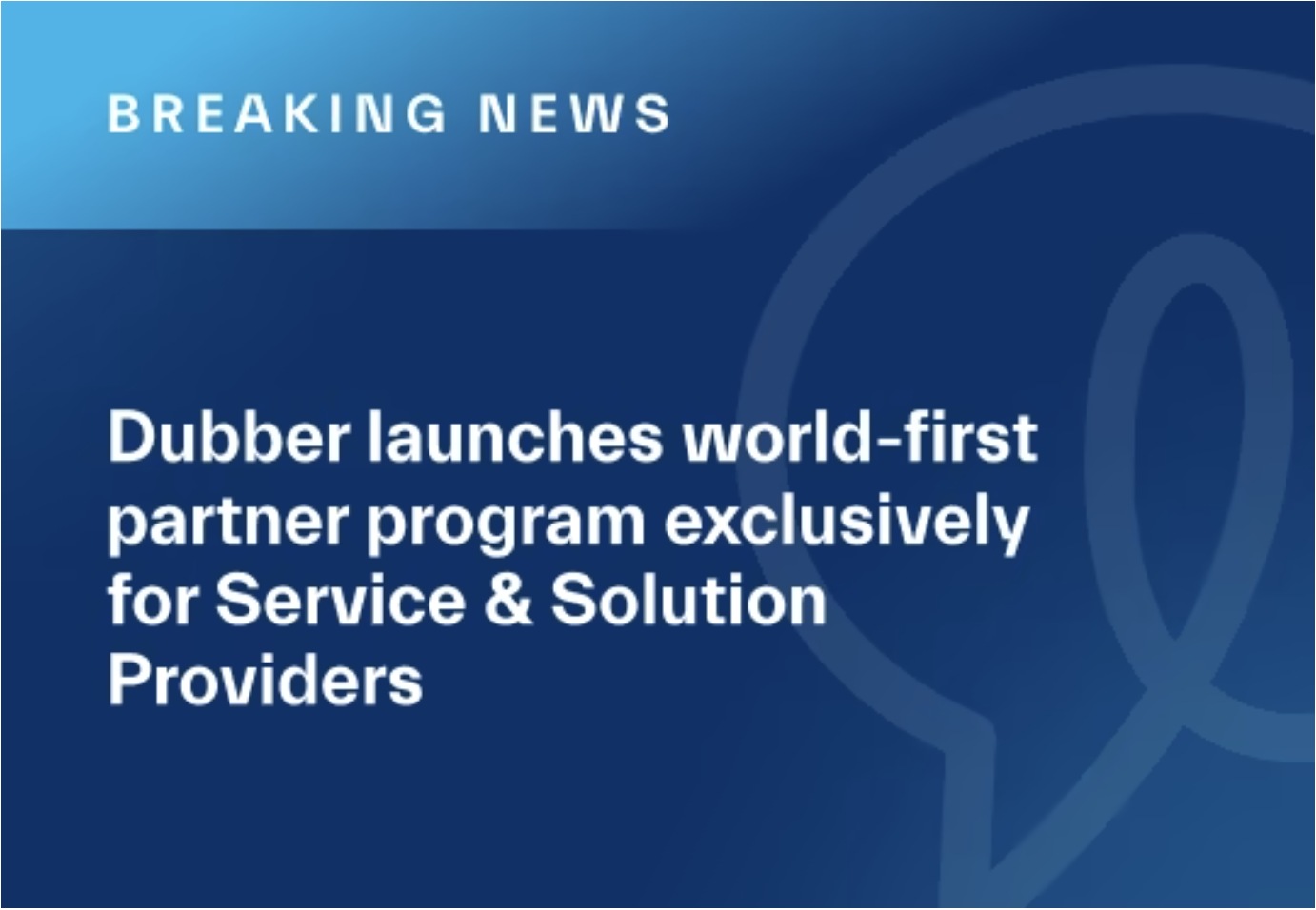
- Unlocks ability of any conversation to be economically transformed into differentiating services and significant revenue streams
- Launches Dubber Go exclusively for Foundation Partners, a call recording product packaged for embedding in any voice service as a standard feature
- Announces Cisco as first major Foundation Partner
Melbourne, Australia, and Dallas, Texas – 3 June 2021 — Dubber Corporation Limited (ASX: DUB) (Dubber), today launched the Dubber Foundation Partner Program and Dubber Go – enabling a call recording product packaged for embedding in any voice service as a standard feature. Both have been designed specifically for service and solution providers to enable cloud-first call recording from within their networks, services and applications.
Cisco is the first global Foundation Partner. Any Cisco Webex Calling and Unified Communications Manager Cloud (UCM-C) customers can use Dubber voice recording at no extra cost instantly accessible directly from Webex Control Hub.
Announcement highlights:
- Dubber available as a standard feature for 100% of Service and Solutions Providers customer base
- Delivers ‘Foundation’ revenue which is accretive without compromising the true value of standard Dubber product offerings
- Supercharges commercial outcomes for Dubber and Foundation Partner
- Dubber able to market and upsell directly to customer from a position of 100% penetration
Executive & Analyst Commentary
“Our new Foundation Program is a key component of our strategy to put AI on every communications device and application,” said Steve McGovern, CEO, Dubber. “It enables Dubber to bring the benefits of call recording to 100% of a service and solution provider’s customer base, delivering the opportunity for accretive revenue and protecting the true value of the Dubber product offering. With the ability to directly, and together, introduce customers to the benefits of unified call recording we are significantly enhancing commercial outcomes.”
“Service and solution providers are in a race globally to create new services based on the content on their networks,” said James Slaney, COO, Dubber. “Conversations are the largest content generator. Until now, much of their value is lost the moment a conversation ends. Today we’re launching an inexpensive, compliant and effective way for Foundation Partners to unlock that value. They’ll be able to create compelling differentiation. Our Foundation Partner program enables new revenue streams which could be worth many hundreds of millions of dollars.”
Dubber Foundation
Dubber Foundation Partners get exclusive access to comprehensive sales, marketing and customer success support. This includes dedicated Dubber sales resources to help customers access unified call recording1.
Dubber Foundation Includes:
- Exclusive access to Dubber Go – enabling basic call recording on all network and solution endpoints at price points that work for both parties
- A multi-tiered pricing and engagement offering. This can support service providers with as few as thousands of subscribers or those with millions
- Deep partner support including dedicated resources to assist in sales, marketing, and customer success
- Access to preferential pricing across all Dubber products that increases margins and revenue
- Available now globally across multiple service types such as UC and mobile networks
- Ability to create and co-design new services with Dubber on the Dubber Voice Intelligence Cloud. An opportunity to build new partnerships and application ecosystems based on voice data
“Our initial work with service and solution providers around the world established that Dubber Foundation Partners can create significant revenue and differentiation while addressing critical customer needs such as compliance, revenue and customer intelligence,” said Adrian Di Pietrantonio, EVP Global Partners. “For a service provider starting with 700,000 customers having access to Dubber Go, potential annual recurring revenue for a service provider could be in the hundreds of millions of dollars.”
Dubber Go
Dubber Foundation partners get exclusive access to Dubber Go. It enables basic call recording with unlimited recordings and 30-day storage for an individual as a standard inclusion in their services. Dubber Go introduces customers to the benefits of being able to compliantly record and replay any conversation whether a call, presentation, training session or video conference.
Dubber Go customers can upgrade to any of Dubber’s products at the click of a mouse.
Unlike other call recording services, Dubber captures and stores conversations in a compliant way. It works in accordance with an enterprise’s security and privacy policies. And, a simple and easy upgrade path to Dubber core and compliance solutions enables enterprise and government customers to access intelligence and features to address compliance mandates. These include retention, legal hold, compliance alerts and easy integration with other compliance systems.
1 Unified Call Recording captures any conversation – voice or video – on any communications service and from any service provider then unifies and stores the data in a form that can be used by anyone with appropriate permission, anywhere in the world at any time.
About Dubber:
Dubber is unlocking the potential of voice data from any call or conversation. Dubber is the world’s most scalable Unified Call Recording service and Voice Intelligence Cloud adopted as core network infrastructure by multiple global leading telecommunications carriers in North America, Europe and Asia Pacific. Dubber allows service providers to offer call recording for compliance, business intelligence, sentiment analysis, AI and more on any phone. Dubber is a disruptive innovator in the multi-billion dollar call recording industry, its Software as a Service offering removes the need for on-premise hardware, applications or costly and limited storage.
For more information, please contact:
Investors: Simon Hinsley simon.hinsley@dubber.net
+61 (0) 401 809 653
UK Media: James Taylor | The PR Network james.taylor@thepr.network
+44 (0)7796 138291
US Media: Charlie Guyer, Guyer Group for Dubbercharlie@guyergroup.com
+1 617 599 8830
AU & NZ Media: Terry Alberstein terry@navigatecommunication.com.au
+61 (0) 458 484 921
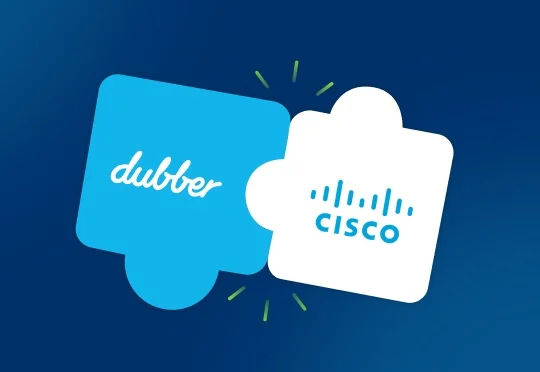
As of today, any Cisco Webex® Calling or UCM Cloud customer can compliantly record, store, share and replay any call. Powered by Dubber, this critical new functionality turns on with a click at zero cost and is included in your Cisco subscription.
If you require additional features such as extended team management, video recording, storage, transcription, sentiment analysis or AI-enriched insights (and much more), it’s simple to upgrade to Dubber solutions from within Cisco’s Control Hub with immediate access and effect.
Users that have compliance or regulatory requirements can easily ensure recording, replay and data storage on Cisco will meet their compliance obligations, regardless of the employee work location. A major concern and need for businesses as a result of the significant shift to remote and hybrid workforce arrangements.
“Customers worldwide are responding to increased regulatory and compliance obligations for their businesses. Embedding tools, like Dubber call recording, as a standard service that is available to Webex users will help customers meet those requirements while enabling easy access to powerful advanced voice data services,” said Lorrissa Horton, Vice President and General Manager of Webex Calling and Online. [Read the blog post]
What’s included
Dubber is the global leader in unified call recording and voice AI solutions for compliance, revenue, customer and people intelligence. Basic call recording within Cisco will get you started on the path to ending not knowing, offering:
- Unlimited recordings of calls
- Cloud capture and compliant storage
- Basic Enterprise controls and policy enforcement
- Easy access, replay, download and share from the Dubber app and web
- 30-day storage
A better way to hit replay
Unlike other embedded recording solutions, Dubber addresses critical data, privacy and regulatory requirements while providing a simple and easy pathway to richer functionality as it is required. Dubber recordings and AI-enriched data can easily be unified in the Dubber Voice Intelligence Cloud alongside conversations from other end-points such as landlines and mobile.
While other solutions offer the ability to record – something we call personal call recording – it’s the kind of recording ideal for an individual but not suitable for business or government. Here are a few of the reasons why:
- Secure cloud storage that can be managed centrally – avoiding privacy, data sovereignty and information leakage risks associated with recording to hardware
- Easily manage who can record and what can be recorded – implementing data and communications policies is made easy
- Controlled provisioning – via the Cisco Control Hub to ensure recordings are only available to eligible employees
Dubber also offers a range of Compliance-specific editions designed to meet the needs of highly regulated organisations and compliance teams.
“Business and Government require more than personal call recording,” said James Slaney, chief operating officer, Dubber. “They need conversations to be captured in a way that is compliant and converted to data for revenue intelligence, dispute resolution, proactive compliance and customer service. Today’s announcement is proof not only of the scalability of Dubber but the potential we and Cisco see in tapping voice data to improve the performance of businesses and governments worldwide.”
How to start doing more with every conversation
Chat to Dubber ready to get your team or organization set up today – or your Cisco rep or partner. Dubber’s customer support team will be standing by to assist with any onboarding or training you or your team needs.
And if you need more than basic call recording for some or all of your users, our teams will assist in upgrading you to the world’s leading unified call recording solutions .

- World’s first voice intelligence solution embedded in major service provider networks and UC solutions like Cisco Webex, Microsoft Teams and Zoom – eliminates need for costly hardware and services
- Purpose-built for compliance teams to specify, manage, record, store, and analyze all communications – voice calls, chat, presentations and more
- Available today globally with immediate provisioning
Melbourne, Australia, and Dallas, Texas – 18 May 2021 — Dubber Corporation Limited (ASX: DUB) (Dubber), today announced new solutions designed to meet the exacting needs of compliance, risk, audit and security professionals.
“Compliance is driving significant demand for capturing conversational content – messaging, chat and video – across any application or end-point,” said James Slaney, COO, Dubber. “Delivering an immutable record of every crucial conversation is essential and demanded by regulators globally. With COVID, the pressure to capture conversations across a multitude of endpoints – from existing Service Provider services through to Cisco Webex, Microsoft Teams and Zoom – has only accelerated. Unified Call Recording makes what used to be a complex task easy.”
With Dubber’s unique reach and Unified Call Recording (UCR), specifically for compliance, companies can capture recordings immediately in one location from all their voice, video and text services, including the 140+ Service Provider networks connected to the Dubber platform globally. This reach and the new solutions for compliance, make Dubber the world’s leading recording option for compliance.
“Dubber continues to transform the economics of call recording and voice data,” said Matthew Townend, Executive Director, Cavell – a leading industry analyst firm. “The benefits of voice intelligence as a service are clear – both to the service providers that will build differentiation through offering it and to businesses and governments that will deploy it to address critical business needs.”
Three new cornerstone compliance solutions mean business and government clients can select flexible and affordable plans that best reflect their needs and compliance practices.
Dubber Compliance offerings enable voice data to be captured economically, at scale. They recognise a smaller number of people need to access the data and that data needs to be isolated from other voice data sets. Dubber allows data integration and portability so any data from any source can be unified on Dubber and connected to other compliance data sets, applications and business intelligence tools.
- Dubber UCR Compliance Edition for compliance leaders with a need to manage, monitor, store and review conversations. Recordings and data from multiple sources can be captured, stored, searched, and reviewed in Dubber, in real-time, without the need for complex queries. Starting at USD $14.95 per month per end-point and up to ten compliance users.
- Dubber Premier Compliance Edition enables a compliance team of up to ten (with additional licenses available) to benefit from AI-enriched insights, alerts, search and sentiment analysis. Additional features include beautiful and insightful transcriptions, legal hold and discovery, and, smart keyword, team and customer search. Starting at USD $29.95 per month per end-point and up to ten compliance users.
- Dubber Voice Intelligence Cloud Compliance Edition ideal for compliance teams who only seek to record calls with confidence, then storing and unifying data in a single easily accessible source of truth. All the features of Dubber Premier Compliance Edition. Plans start at USD $1,599.99 for 250 endpoints and one user access – with additional plans for more end-points and users.
All Dubber solutions include critical features such as unlimited storage, access to the easy to use Dubber application for IOS, Android and Web, concierge set-up and training, data download and export, 24×7 online global support — and, seamless, high-quality media capture across devices and all supported endpoints for audio, video, screen share, and chat.
Critically, Dubber Compliance Solutions answer the need for policy-based recording. Organizations that adopt Dubber can easily implement compliance and administrative policies such as when calls and online meetings should be automatically recorded and captured for subsequent processing and retention as required by relevant corporate or regulatory policy.
Dubber solutions are native to the world’s leading communications solutions, including Cisco Webex, Microsoft Teams, and Zoom, and the world’s leading networks such as AT&T, Verizon, Tetstra and Cox Communications. Conversations, once captured, are stored in Dubber Cloud Storage and then processed in the Dubber Voice Intelligence Cloud – where AI creates real-time insights, alerts, and more.
Public data from key regulators including the FCA in the United Kingdom and the CFTC and SEC in the United States show that fines levied for communication compliance monitoring topped $150,000,000 in 2019. Regulatory focus continues to increase with FINRA highlighting digital communications, including collaboration platforms, as a priority for its 2020 broker-dealer examinations.
Regulations and regulators requiring an accurate record of conversations to satisfy know-your-customer, data protection and privacy mandates include MiFID II, Dodd-Frank, ASIC, APRA, AUSTRAC, PCI, SOX, FCA, FINRA and regulators globally.
“Our new solutions make Unified Call Recording more flexible and available to businesses and teams of any size,” said Slaney. “We founded Dubber to eliminate the cost and complexity of capturing any conversation. For too many, the value of that conversation is lost the moment it ends. We’re making it simpler and easier than ever to end not knowing and comply.”
Key compliance activities are made simple and easy with Dubber automating key tasks:
- Collect and integrate recordings and data in the manner required to meet compliance obligations in appropriate regional boundaries
- Real-time search for interactions based on communication-related metadata or interaction content. Common examples include:
- Metadata – participants, time, direction, dialled number, origin number, custom business data
- Content – transcription, sentiment, phonetics, related interactions
- Analyze and interact with collected communications, including the ability to monitor interactions as they are being collected
- Ensure security of collected communications and prevent tampering at all stages
- Retention policies support retain and delete action,; and, legal hold and discovery on historical and real-time data
Resources
- Pricing information: https://www.dubber.net/pricing
- Blog post: https://www.dubber.net/news
- Brochure: http://www.dubber.net/wp-content/uploads/2021/05/PP-One-Pager-Comp.pdf
- Press release: https://www.prnewswire.com/news-releases/dubber-launches-three-new-compliance-solutions-301292361.html
About Dubber:
Dubber is unlocking the potential of voice data from any call or conversation. Dubber is the world’s most scalable Unified Call Recording service and Voice Intelligence Cloud adopted as core network infrastructure by multiple global leading telecommunications carriers in North America, Europe and Asia Pacific. Dubber allows service providers to offer call recording for compliance, business intelligence, sentiment analysis, AI and more on any phone. Dubber is a disruptive innovator in the multi-billion dollar call recording industry, its Software as a Service offering removes the need for on-premise hardware, applications or costly and limited storage.
For more information, please contact:
Investors: Simon Hinsleysimon.hinsley@dubber.net
+61 (0) 401 809 653
UK Media: James Taylor | The PR Network james.taylor@thepr.network
+44 (0)7796 138291
AU & NZ Media: Terry Alberstein terry@navigatecommunication.com.au
+61 (0) 458 484 921
US Media: Charlie Guyer, Guyer Group for Dubbercharlie@guyergroup.com
+1.617.599.8830
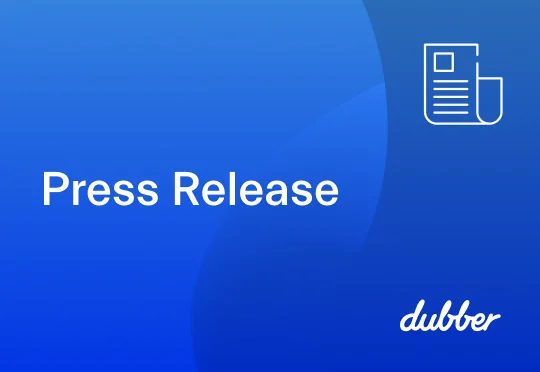
- Answers global demand for unified call recording and voice intelligence across any communications end-point with the world’s most comprehensive and advanced product family
- Creates seamless ability to enrich any conversation with AI and share with business applications
- Simple, easy to deploy, flexible monthly and annual plans
- New solutions designed specifically for compliance managers and teams
Melbourne, Australia, and Dallas, Texas – 18 May 2021 — Dubber Corporation Limited (ASX: DUB) (Dubber), today announced 12 new products and solutions, more than tripling its industry-leading voice intelligence offerings for service and solution providers, business and government. The new solutions are available today directly from Dubber on eligible networks and solutions. Dubber’s existing solutions, CallDub and DubAI continue to be offered across all networks.
“Unified Call Recording is critical to achieving the compliance, revenue, and customer insights demanded by business and government today,” said James Slaney, COO, Dubber.
“More than 80% of crucial conversations with customers and employees take place using voice. Not having access to accurate, compliant records in real-time puts leaders at a serious disadvantage. Dubber addresses that by unlocking the insights in every conversation.”
“Dubber continues to transform the economics of call recording and voice data,” said Matthew Townend, Executive Director, Cavell – a leading industry analyst firm. “The benefits of voice intelligence as a service are clear – both to the service providers that will build differentiation through offering it and to businesses and governments that will deploy it to address critical business needs.”
Three new core Dubber solutions
At the heart of today’s announcement are three new core solutions. They give business and government customers flexible, affordable options so that users or teams can capture and use voice intelligence – from recordings to transcriptions to sentiment analysis.
- Dubber You delivers Unified Call Recording where individuals need to record, store and review crucial conversations. Dubber You automates the recording of calls, meetings and video without the need for hardware or software and comes with unlimited lifetime storage. Plans start at USD $14.95 per month per recording endpoint.
- Dubber Teams is ideal for managers and leaders needing central review and control over 100% accurate and enforced recordings and data for sales, service, and customer insights. Plans start at USD $19.95 per month per recording endpoint.
- Dubber Premier unlocks all Dubber functionality delivering AI-enriched insights. Beautiful transcriptions, alerts and notifications and the ability to easily integrate Dubber with business intelligence and CRM applications. Plans start at USD $49.95 per month per recording endpoint.
All Dubber solutions include critical features such as unlimited storage, easy-to-use application for iOS, Android and Web, concierge set-up and training, data download and export and 24×7 online global support.
“Our new solutions make Unified Call Recording more flexible and available to businesses and teams of any size,” said Slaney. “We founded Dubber to eliminate the cost and complexity of capturing any conversation. For too many, the value of that conversation is lost the moment it ends. We’re making it simpler and easier than ever to end not knowing and comply.”
Users can easily expand any package with simple to deploy add-ons including:
- UCR Service Add-on Pack – easily add services with a click – review and manage recordings, transcriptions and data in one place
- Dubber API – easily connect Dubber recordings and data to applications, storage and dashboards
- Dubber Call Recording Archive – redundant and secure storage of all call recordings and data with Dubber Storage. Back up your valuable voice data in the Dubber Voice Intelligence Cloud, including recordings and data from other sources
- Dubber for Salesforce – add your Dubber recordings, metadata, transcriptions and sentiment insights to Salesforce records
Native to the world’s networks and communications solutions
Dubber is native to the world’s leading communications solutions, including Cisco, Microsoft, and Zoom. Its partners span more than 140+ of the world’s leading networks, including AT&T, Verizon, Telstra and Cox Communications.
With Dubber’s unique reach and Unified Call Recording (UCR), specifically for compliance, companies can capture recordings immediately in one location from all their voice, video and text services. Conversations, once automatically captured, are stored in Dubber Cloud Storage and then processed in the Dubber Voice Intelligence Cloud – where AI creates real-time insights, alerts, and more.
This reach and the new solutions for compliance, make Dubber the world’s leading and most flexible recording option for compliance.
Transforming how conversations are captured and used
Dubber solutions support continuous compliance and voice intelligence with critical features including:
- Collect and integrate recordings and data in the manner required to meet compliance obligations appropriate to regional regulations
- Real-time search of interactions based on communication-related metadata or conversational content. Common examples include:
- Analyze and interact with collected communications, including the ability to monitor interactions as they are being collected
- Ensure security of collected communications and prevent tampering at all stages
- Retention policies support retain and delete actions; and, legal hold and discovery on historical and real-time data
- Metadata – participants, time, direction, dialled number, origin number, custom business data
- Content – transcription, sentiment, phonetics, related interactions
Dubber also announced today a full suite of solutions designed specifically for the demanding needs of compliance, legal, security, risk and audit teams.
Call Dub and Dub AI, Dubber’s existing solutions, will continue to be provided by partners and service and solution providers globally for the foreseeable future.
Resources
- Pricing information: https://www.dubber.net/pricing
- Blog post: https://www.dubber.net/news
- Brochures quick link: https://www.dubber.net/brochure
- Press release: https://www.prnewswire.com/news-releases/dubber-launches-12-next-generation-unified-call-recording-solutions-301292378.html
About Dubber:
Dubber is unlocking the potential of voice data from any call or conversation. Dubber is the world’s most scalable Unified Call Recording service and Voice Intelligence Cloud adopted as core network infrastructure by multiple global leading telecommunications carriers in North America, Europe and Asia Pacific. Dubber allows service providers to offer call recording for compliance, business intelligence, sentiment analysis, AI and more on any phone. Dubber is a disruptive innovator in the multi-billion dollar call recording industry, its Software as a Service offering removes the need for on-premise hardware, applications or costly and limited storage.
For more information, please contact:
Investors: Simon Hinsleysimon.hinsley@dubber.net+61 (0) 401 809 653
UK Media: James Taylor | The PR Network james.taylor@thepr.network +44 (0)7796 138291
AU & NZ Media: Terry Alberstein terry@navigatecommunication.com.au+61 (0) 458 484 921
US Media: Charlie Guyer, Guyer Group for Dubbercharlie@guyergroup.com+1.617.599.8830
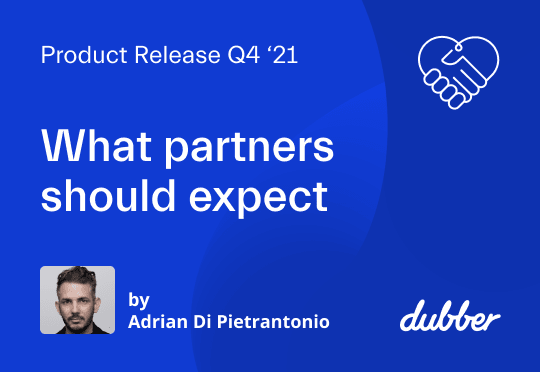
Today we announced over 12 new solutions giving our partners more ability than ever before to differentiate, drive revenue and engage customers.
With Dubber’s unique reach and Unified Call Recording (UCR), specifically for compliance, companies can capture recordings immediately in one location from all their voice, video and text services, including the 140+ Service Provider networks connected to the Dubber platform globally. This reach and the new solutions for compliance, make Dubber the world leading recording option for compliance, revenue and customer intelligence.
We’ll be working closely with our global service and solution providers to enable Dubber You, Dubber Teams and Dubber Premier on their networks and services. From today they are available on MS Teams, Cisco, Zoom and other major UC solutions. And, our new Compliance Solutions are available today on all platforms.
A New Source of Advantage
Unified Call Recording (UCR) breaks the constraints of legacy call recording. We designed Dubber’s new UCR solutions to reflect the way customers use conversational data – whether recordings, beautiful transcriptions or sentiment analytics.
And, they enable customers to store and process any recording – from any endpoint or voice recording solution – in the Dubber Voice Intelligence Cloud.
Channel partners will be able to design fit-for-purpose solutions that answer the needs of the smallest and largest businesses.
For a small business that might mean Dubber You capturing calls for rapid dispute resolution and automagically enriching customer records in Salesforce with the conversation.
A call centre will use Dubber Teams to capture all calls across the primary SIP connection and Cisco Webex, unifying records in the Dubber Voice Intelligence Cloud and using the data to fuel insights in dashboards.
Compliance teams can now access purpose-built solutions. They can mine compliant data sets for audits, investigations and discovery. Keyword and sentiment reporting will move them from a reactive to a proactive footing.
What’s next?
Over the coming weeks, we will be hosting a series of webinars to take you through the new solutions and what they mean for you.
In the meantime, our industry-leading products – CallDub and DubAI are still available. But expect the new solutions to appear quickly in major networks and UC solutions.

Quick Read
- Three new compliance solutions designed to economically enable conversation recording across many end-points — giving compliance teams the tools they need to manage, store, review and monitor conversations.
- Turn on end-points across multiple services and solutions – aggregate data in one place – the Dubber Voice Intelligence Cloud
- AI does the heavy compliance work, generating insights, alerts and powering workflows
- Dubber compliance solutions being implemented today by leading Financial Services institutions globally
Compliance, risk, audit and leaders in regulated industries need a better answer to global mandates to know the customer and record conversations. We know because they told us as we were working on the new core Dubber solutions.
We were told about an industry where customers were charged for recording on any and every endpoint bundled with a range of features for every user – when only a few needed access to those features.
Regulated industry leaders told us they need a more economical and secure way to capture every conversation. The data has to be stored with certainty. And they need better access to data and insights.
It would be a small number of personnel accessing the data and that data had to be protected.
We heard about a need to break voice data silos. In the past compliance professionals had to jump between recordings captured in the call centre to recordings for, say, Zoom in a compliance app.
Every data silo introduces cost, complexity and compliance risk. These are three things Dubber set out to eliminate.
Compliant, Unified Call Recording
So, we set about creating the first unified call recording and voice intelligence solution purpose-built for compliance teams.
Compliance drives significant demand for capturing conversational content. It covers messaging, chat and video. And that content can come from any application or end-point. Delivering an immutable record of every crucial conversation is essential. It’s also what regulators around the world now demand.
With COVID, the pressure to capture conversations across a multitude of endpoints – from Cisco WebEx to Microsoft Teams and Zoom – has accelerated. Unified Call Recording makes what used to be a complex task easy.
Today we’re unveiling three new cornerstone compliance solutions that mean business and government can select flexible and affordable plans that best reflect their needs and compliance practices.
Changing the Economics of Conversational Compliance
Dubber Compliance offerings capture voice data economically, at scale. They recognise a smaller number of people who need to access the data and the need to isolate that data from other voice data sets.
Dubber allows data integration and portability so any data from any source can be unified on Dubber and connected to other compliance data sets, applications and business intelligence tools.
- Dubber UCR Compliance Edition for compliance leaders with a need to manage, monitor, store and review conversations. Dubber captures and stores recordings and data from multiple sources in real-time. Once there it can be searched, and reviewed, still in real-time, without the need for complex queries. Starting at $14.95 per month per end-point and up to ten compliance users.
- Dubber Premier Compliance Edition enables a compliance team of up to ten (with additional licenses available) to benefit from AI-enriched insights, alerts, search and sentiment analysis. Additional features include beautiful and insightful transcriptions; legal hold and discovery; and, smart keyword, team and customer search. Starting at $29.95 per month per end-point and up to ten compliance users.
- Dubber Voice Intelligence Cloud Compliance Edition is ideal for compliance teams who only seek to record calls with confidence, then storing and unifying data in a single easily accessible source of truth. All the features of Dubber Premier Compliance Edition. Plans start at $1,599.99 for250 endpoints and one user access – with additional plans for more end-points and users.
All Dubber solutions include critical features such as unlimited storage; access to the easy to use Dubber application for IOS, Android and Web; concierge set-up and training; data download and export 24×7 online global support — and, seamless, high-quality media capture across devices and all supported endpoints for audio, video, screen share, and chat.
Policy-Based Unified Call Recording
Critically, Dubber Compliance Solutions answer the need for policy-based recording.
Dubber makes it easy for organizations to set compliance and administrative policies such as when calls and online meetings should be automatically recorded and captured for subsequent processing and retention as required by relevant corporate or regulatory policy.
Public data from key regulators including the FCA in the United Kingdom and the CFTC and SEC in the United States show that fines levied for communication compliance monitoring topped $150,000,000 in 2019. Regulatory focus continues to increase: FINRA highlighted digital communications, including collaboration platforms, as a priority for its 2020 broker-dealer examinations.
Regulations and regulators requiring an accurate record of conversations to satisfy know-your-customer, data protection and privacy mandates include MiFID II, Frank Dodd, ASIC, APRA, PCI, SOX, FCA, FINRA and Reserve Banks globally.
More Flexible, More Available
Our new solutions make Unified Call Recording more flexible and available to businesses and teams of any size. We founded Dubber to eliminate the cost and complexity of capturing any conversation. For too many, the value of that conversation is lost the moment it ends. We’re making it simpler and easier than ever to end not knowing and comply.
Dubber makes key compliance activities simple and easy by automating key tasks:
- Collect and integrate recordings and data in the manner required to meet compliance obligations in appropriate regional boundaries.
- Real-time search for interactions based on communication-related metadata or interaction content. Common examples include:
- Analyze and interact with collected communications, including the ability to monitor interactions as they are being collected.
- Ensure security of collected communications and prevent tampering at all stages
- Retention policies support retain and delete actions; and, legal hold and discovery on historical and real-time data
- Metadata – Participants, time, direction, dialled number, origin number, Custom business data
- Content – Transcription, sentiment, phonetics, related interactions
As with all the solutions we’re announcing today, we’re just getting started.

